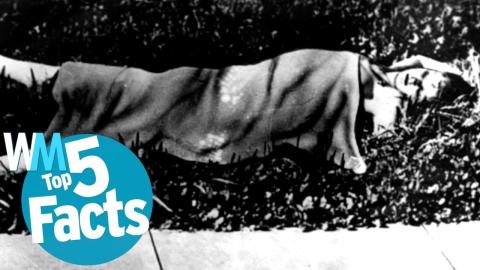Top 5 Black Dahlia Murder Facts

Special thanks to our user christo for submitting the idea on our Interactive Suggestion Tool at http://www.WatchMojo.comsuggest
#5: Her Murder Shocked the Los Angeles Community
The murder of Elizabeth Short is probably most remembered by criminologists for its shocking violence, as well as the frank and specific disposal of her body. Her corpse was discovered by a woman walking with her young child near a vacant lot on the morning of January 15th, 1947. The nude body had been severed at the waist, and there was hardly any blood at the scene, implying Short had been murdered elsewhere, had her blood drained, and was then moved to the location. Finally, her body was posed, legs spread, arms bent over her head. Short's murder captured the Los Angeles community's attention almost immediately, with many of the city's local papers scrambling to piece together as much information as they could about this beautiful, mysterious young woman who, at only 22 years old, started down her tragic road as "The Black Dahlia."
#4: There Is a Wealth of Misinformation and Fiction About Elizabeth Short
In the late 40s, newspapers were the source of news, and had a vested interest in making the news titillating. The Los Angeles Examiner, owned by tabloid magnate William Randolph Hearst, was at the forefront of covering this story. The press created the “Black Dahlia" moniker almost immediately following her death, a lazy reference to a popular movie of the time called "The Blue Dahlia." Overall, the press sensationalized the story by creating Short into some boulevard-prowling, loose-moraled woman of the night. Sadly, the inventions didn’t end with the papers, as various books kept the rumor mill turning. Among them were allegations that Short was born a hermaphrodite, that she was a prostitute who worked with Marilyn Monroe as a double act, or even that important men had impregnated her and, as a result, had her murdered by the mob. Short's childhood friend Mary Pacios even authored a book in 1999 where she suggested that Orson Welles was the killer. None of these insinuations were true.
#3: A Man Claiming to Be Short's Killer Sent Her Belongings to the Local News
The editor of the Los Angeles Herald-Express received a phone call from a man claiming to be Elizabeth Short's killer less than ten days after her body was found in Los Angeles. The man promised to mail proof of his crime, and soon afterward, a package was intercepted by the postal service after being dropped into a public mailbox. The package contained, among other articles, Short's birth certificate, a Greyhound Bus claim check, an address book with the name "Mark Hansen" on it, and a Western Union telegram signed "Red.". "Red" was the nickname of Robert Manley, a traveling salesman who dropped off Short to the last place where she was seen, the Biltmore Hotel, on January 9th, 1947. The package itself was soaked with gasoline, likely intended to remove fingerprints. The crime lab nevertheless managed to pull some prints, but to this day the prints don’t match any on file, leading investigators to surmise that this was the killer’s one and only crime.
#2: The Black Dahlia Files Are Still Closed to Public
The murder of Elizabeth Short remains open and unsolved, pending new evidence, as one of history's most high profile cold cases. The files of the Black Dahlia Murder remain closed to the public, however, with only one Los Angeles homicide detective possessing access to the four file cabinets in which the files are kept. This detective is known as "The Gatekeeper," who then passes along this charge to another single detective down the line. Of course, whenever there is secrecy involved conspiracies theories abound. However, due to the age of the case, security levels should probably considered moot, as everyone who knew Betty Short is probably dead. She herself would've turned 90 in 2014, making her murder one whose hidden secrets will most likely remain that way for the foreseeable future.
#1: A Police Error Might Have Let the Killer Walk
The police first encountered Leslie Dillon, an embalmer’s assistant, after he began a correspondence about the case with police psychiatrist J. Paul de River. Dillon had the skills required to drain blood from her body, lived within walking distance of the dumpster where Short's shoes and handbag were found, and could not be accounted for during the time of Short's murder. Suspecting Dillon was their man, police booked him and tried to get a confession. However, Dillon was held against his will and without access to an attorney, making it an illegal detention and effectively nullifying any headway the police had made in their investigation. Partially in response to this fiasco, a special, investigative Grand Jury was empanelled, with the results of this inquiry revealing rampant corruption at the highest levels of the LAPD. Petty jealousies and alliances led to the department's inability to solve a rash of violent crimes against women, including the Black Dahlia Murder.
So, can you crack this cold case? And do you think more of the case files should be open to the public? For more Gatekeeper top tens and bled dry top fives, be sure to subscribe to WatchMojo.com.
